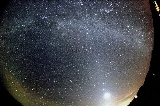
Orionids
Overview
Meteor shower
A meteor shower is a celestial event in which a number of meteors are observed to radiate from one point in the night sky. These meteors are caused by streams of cosmic debris called meteoroids entering Earth's atmosphere at extremely high speeds on parallel trajectories. Most meteors are smaller...
associated with Halley's Comet. The Orionids are so-called because the point they appear to come from, called the radiant
Radiant (meteor shower)
The radiant or apparent radiant of a meteor shower is the point in the sky, from which meteors appear to originate. The Perseids, for example, are meteors which appear to come from a point within the constellation of Perseus....
, lies in the constellation
Constellation
In modern astronomy, a constellation is an internationally defined area of the celestial sphere. These areas are grouped around asterisms, patterns formed by prominent stars within apparent proximity to one another on Earth's night sky....
Orion
Orion (constellation)
Orion, often referred to as The Hunter, is a prominent constellation located on the celestial equator and visible throughout the world. It is one of the most conspicuous, and most recognizable constellations in the night sky...
. Orionids are an annual meteor shower
Meteor shower
A meteor shower is a celestial event in which a number of meteors are observed to radiate from one point in the night sky. These meteors are caused by streams of cosmic debris called meteoroids entering Earth's atmosphere at extremely high speeds on parallel trajectories. Most meteors are smaller...
which last approximately one week in late-October. In some years, meteors may occur at rates of 50-70 per hour.
Meteor showers first designated "shooting stars" were connected to comets in the 1800s.

